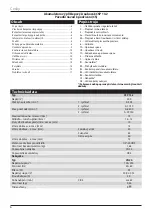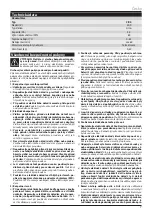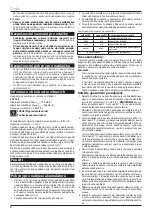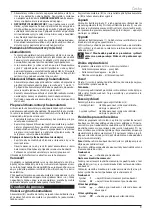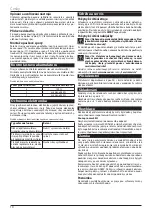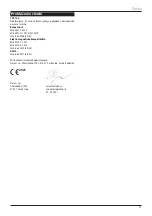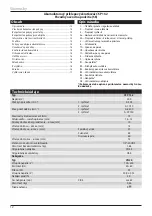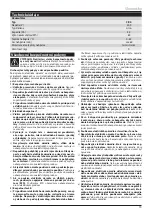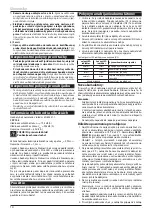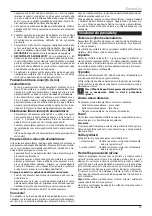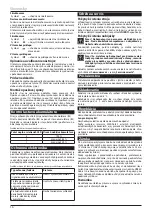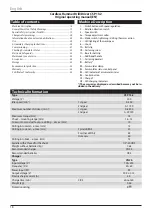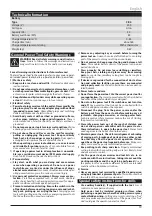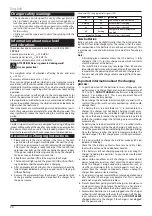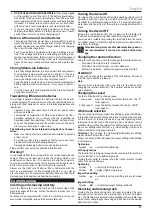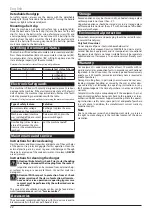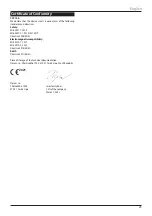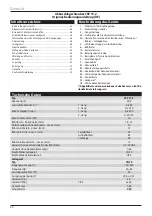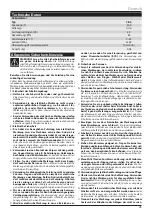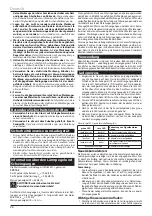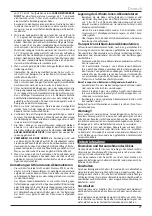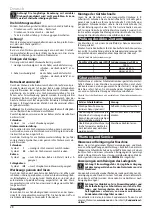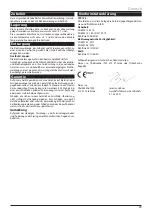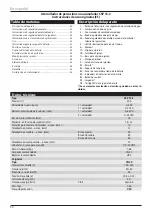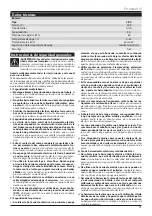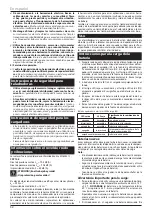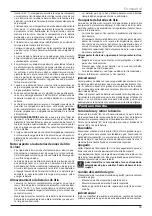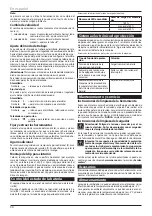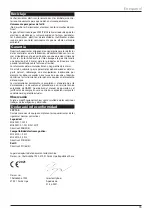
English
20
Charger safety warnings
– This appliance is not designed for use by other people (chil-
dren included), physical, sensory or mental incapability or
lack of experience and knowledge of whose prevent from safe
use of the appliance without being supervised, or without be-
ing instructed on use of the appliance by a person responsible
for their safety.
– Children should be supervised to avoid their playing with the
appliance.
Information about noise level
and vibrations
The values have been measured in conformity with EN 62841-1�
CSP 13-2
Acoustic pressure level L
pA
= 79�8 dB (A)�
Acoustic power level L
wA
= 90�8 dB (A)�
In accuracy of measurements K = 5�0 dB (A)�
ATTENTION! Noise is generated during work!
Use ear protection!
The weighted value of vibrations affecting hands and arms
a
h
= 2�92 m�s
-2
�
In accuracy of measurements K = 1�5 m�s
-2
�
The emission values specified (vibration, noise) were measured in
accordance with the test conditions stipulated in EN 62481 and are
intended for machine comparisons� They are also used for making
preliminary estimates regarding vibration and noise loads during
operation�
The emission values specified refer to the main applications for
which the power tool is used� If the electric power tool is used for
other applications, with other tools or is not maintained sufficient-
ly prior to operation, however, the vibration and noise load may be
higher when the tool is used�
Take into account any machine idling times and downtimes to esti-
mate these values more accurately for a specified time period� This
may significantly reduce the load during the machine operating
period�
Use
Cordless impact screwdrivers are designed for driving, drilling and
impact drilling without the need for connection to a power outlet�
This device may only be used for the intended purposes� The user
bears full responsibility for the consequences of unintended use�
Accumulator Charging Instructions
1� Please make sure the mains voltage is the same as the volt-
age listed on the charger’s machine plate� Connect the charg-
er (N1) to a power source� A red LED indicator (N2) will light up�
This means the charger is ready to charge� If the red LED indi-
cator does not light up, check the connection to power supply�
If the power supply functioning correctly, bring the charger in
for repair to an authorised service centre!
2� Slide the accumulator (B1) all the way into the charger�
3� The red LED will light up and the green LED (N2) will start flash-
ing to indicate that the accumulator is charging�
4� After approximately 60 minutes, the accumulator should be
fully charged, indicated by the green and red LED staying lit
without flashing�
5� Remove the accumulator from the charger� If you do not wish
to charge another accumulator, disconnect the charger from
the power source�
Overview of LED charging indicator signals (N2):
Green LED
Red LED
Meaning
off
on
connected to a power source
flashing
on
accumulator is charging
on
on
accumulator is charged
off
flashing
charger or battery temperature
too high
alternately flashing
accumulator is damaged
New batteries:
Battery capacity may be slightly smaller than the listed value dur-
ing the first few initial charge cycles� The reason is that the chem-
ical composition of the batteries has not been activated yet� This
is a temporary issue and will resolve on its own after a few charge
cycles�
Note:
• A blinking green indicator means that the battery is fully
charged or that it is in slow charge mode, which maintains
a low charge level of the battery�
• The initial battery charge may take longer then 60 minutes
(according to battery capacity) depending on the environment
temperature, the power supply and the current charge level�
• If you are not using the charger, please unplug it from the pow-
er source�
Important information about the charging
process:
1� To get the best out of the batteries in terms of longevity and
performance is to charge them at an ambient temperature of
18 °C to 24 °C�
DO NOT CHARGE
the batteries at temperatures
below 0 °C and above 45 °C� This is very important� You will
prevent serious battery damage�
• Do not charge the batteries in direct sunlight, especially in the
summer! You will prevent extreme overheating, which could
damage them!
2� If a battery that is too cold (below 0 °C) is inserted into the
charger, the charger will not begin charging it right away;
instead, the green and the red indicator light will begin blink-
ing� Once the battery reaches the right temperature naturally
(within the standard range), the fast charge process will begin
automatically�
• If a battery that is too hot (more than 45 °C), is inserted into the
charger, the charger will not begin charging it right away; in-
stead, the green and the red indicator light will begin blinking�
Once the battery reaches the right temperature (within the
standard range), the fast charge process will begin automat-
ically�
3� If it is not possible to charge the batteries properly (the red
indicator is blinking):
• Check that the battery contact surfaces are not dirty� Clean
them with a cotton wad and alcohol as needed�
• If the battery is still not charging properly, send or bring the
charger (including the batteries) to your nearest authorised
service centre�
4� Under certain conditions and if the charger is connected to
power, foreign material may short circuit the charge contacts
inside the charger� Foreign conducting substances, such as
steel fibres, aluminium foils or metal deposits must be re-
moved from the charger continuously� Always unplug the
charger from power prior to cleaning�
5� If you are carrying out several different charge operations one
after the other, the charger may become hot� This is normal
and is not a sign of a technical problem�
6� Prevent liquid from getting inside the charger as it could cause
an electrical injury� Do not place the battery in a hot environ-
ment if you wish to facilitate the battery cool down process�
7� Accumulator batteries can remain plugged into the charger
without a risk of damage to them or the charger itself� The bat-
teries will remain fully charged in the charger�
DO NOT LEAVE
charged batteries in the charger if the charger is not plugged
into the power outlet�
Содержание CSP 13-2
Страница 4: ...4 6 4a 4b 9 3 2 5 1 B4 B2 7a 8 7b 7c B2 B1 B3 B1 B5 B3 N2 N1...
Страница 5: ...5...
Страница 49: ...o 49 1 2 a RCD RCD 3 a 4 a CB 4 20 0 Li Ion 4 0 80 C 0 45 60 0 67...
Страница 50: ...o 50 5 a 62841 1 CSP 13 2 LpA 79 8 A LwA 90 8 A K 5 0 A ah 2 92 2 K 1 5 2 EN 62481 1 N1 N2 2 B1 3 N2 4 60 5 N2...
Страница 51: ...o 51 60 1 18 C 24 C 0 C 45 C 2 0 C 45 C 3 4 5 6 7 8 9 Li Ion 5 C 40 C...
Страница 52: ...o 52 B1 B1 B2 B1 B1 5 B1 B2 3 1 1 2 2 4b 6b 4a 1 23 6 8 9 7a 7c 7a 7b B3 B4 B3 B5 3 100 2 60 1 30...

